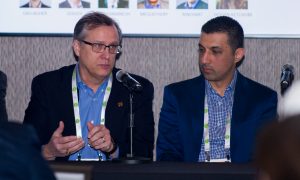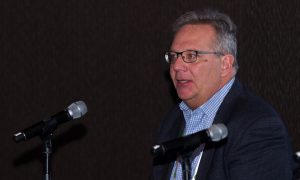Sports Venue Production Summit: The Shift to IP Isn’t Easy, but the Long-Term Benefits Are Great
Those experienced in the new tech share their thoughts on investing for the future
Story Highlights
In video transmission and architecture, one big decision faces every new sports venue: do we go all-in on IP? IP technologies promise the streamlining of workflows and the flexibility to embrace future technologies in ways that baseband simply cannot do. In its current state, however, implementing IP is loaded with challenges.

From left: University of Notre Dame’s Scott Rinehart (left) and Evertz’s Nima Malekmanesh spoke on the challenges and opportunities of an IP-based media infrastructure during a panel discussion at the 2018 SVG Sports Venue Production Summit.
At the Sports Venue Production Summit at Mercedes-Benz Stadium in Atlanta last week, industry leaders shared their thoughts, trials, and hopes related to their experiences with IP-based technologies within a sports venue or media center. Although the move to IP is happening at a rapid pace, it’s still early days, and a wealth of obstacles are still to be sorted out as standards — such the recently published SMPTE 2110 — become engrained in the business and technology vendors churn out more and more IP-based solutions.
“In a simple way, IP should mean flexibility,” said Nima Malekmanesh, product marketing manager/senior engineer, DreamCatcher, Evertz. “Moving away from baseband into IP means embracing new technology, new formats, a change in the way you do your production relatively easily.”
Said Jeff Gouch, sales manager, sports venues, the Americas, EVS, “We are on the first step of a pretty long path. While we talk a lot about the replacement of traditional video core with IP switches, we have to remember what comes next: the benefits of moving toward IP.
“IP is going to touch a lot of different things,” he continued. “It’s not just the transport of video or audio from point A to point B. It’s the flexibility of that and the tools that can take advantage of that network on top. We’re going to see improved workflows, improved flexibility, so more content faster that can be put either on large screens or to an IPTV system. That IP backbone is going to enable a lot of this as products catch up to take advantage of it.”
The flexibility promised by IP also breaks down bottlenecks and barriers to creating and distributing more content to multiple destinations in an increasingly content-hungry digital world.
“For your fans, it’s access to content,” said Malekmanesh. “Really, what you are trying to do is get them different types of content and immediate access to that content. Give them something they won’t get at home. Maybe it’s an angle or a zoom that they wouldn’t get on the traditional television broadcast. On the frontend, IP simply means more flexibility: if you decide to bring in some high-frame-rate cameras and introduce a new workflow, on the baseband side, that would be very limiting. In IP, that becomes much easier.”

TVU Networks’ Gerry Gallagher (right) discusses his company’s IP-based solutions as Diversified’s Mike Meglathery looks on.
IP also promises benefits not only in moving signals internally within a venue but also in improved connectivity that allows other entities to move signals in and out of the building more cleanly.
“We can start to bring efficiencies to the workflow, to production, and to the economics,” said Gerry Gallagher, senior director, solutions, TVU Networks, which is developing IP solutions to improve the quick moving of content in implementing “at-home” production models. “That allows rightsholders to bring more of the content to their fans. That’s a huge part of [at-home] productions that everyone is seeing: we can start doing productions that, before, may not have made much economic sense. Now those are feasible and economically worthwhile.”
Perhaps the biggest lesson reported by two of the speakers on the panel is to not take the challenges of IP lightly.
“IP is really hard,” noted Scott Rinehart, director, broadcast technology, University of Notre Dame, which, in the past year, has opened an all-IP facility in the Martin Media Center. “If anyone tells you that it’s easy, they are not telling you the truth. It is difficult; there are tens of thousands of IP addresses in our system. To have all of those things line up, all of your naming conventions line up, and all of your audio line up, and all the audio and video get there at the same time when it’s AES vs. IP: these are things you don’t know before you do it.”
At Mercedes-Benz Stadium, integrator Diversified worked alongside WJHW and AMB Sports + Entertainment to build out the video infrastructure. The original plans called for a side-by-side build of a baseband and an IP architecture, but, as the project was under way, it was agreed on to fully embrace an all-IP backbone.

EVS’s Jeff Gouch reported on the benefits of IP-based technology but emphasized that, in many ways, it’s still early days.
“Yes, it was a huge learning curve, and there were a lot of interoperability problems between vendors that we needed to work through,” said Mike Meglathery, project manager/senior project engineer, Diversified, who oversaw the Mercedes-Benz Stadium project. “I won’t say that it was an easy task. Our commissioning time was dramatically longer on this job than it would be on a standard job, but we knew what the end goal was and what was required. That being said, the manufacturers are working like crazy to make this significantly easier. The metadata communication between the vendors and the interoperability are really key to the industry, and they are recognizing that.”
The rapid move to work in current standards — such as ASPEN — while anticipating the wide adoption of SMPTE 2110 has even those fighting through the early challenges still feeling very optimistic for the future.
“I think the benefits that we’re going to see with this IP infrastructure that Notre Dame has built are not today,” said Rinehart. “The user interfaces are all the same. Everybody is switching the same, doing replays the same way, audio the same way with faders. The benefit is going to be in three to five years when [the tech vendors] start working on the same platform; that’s where [SMPTE] 2110 comes in. Now we’re talking the same language as we go out, and things will become more plug-and-play. We’re just not there yet because it’s so new, but the benefits, I think, are extraordinary going forward.”
